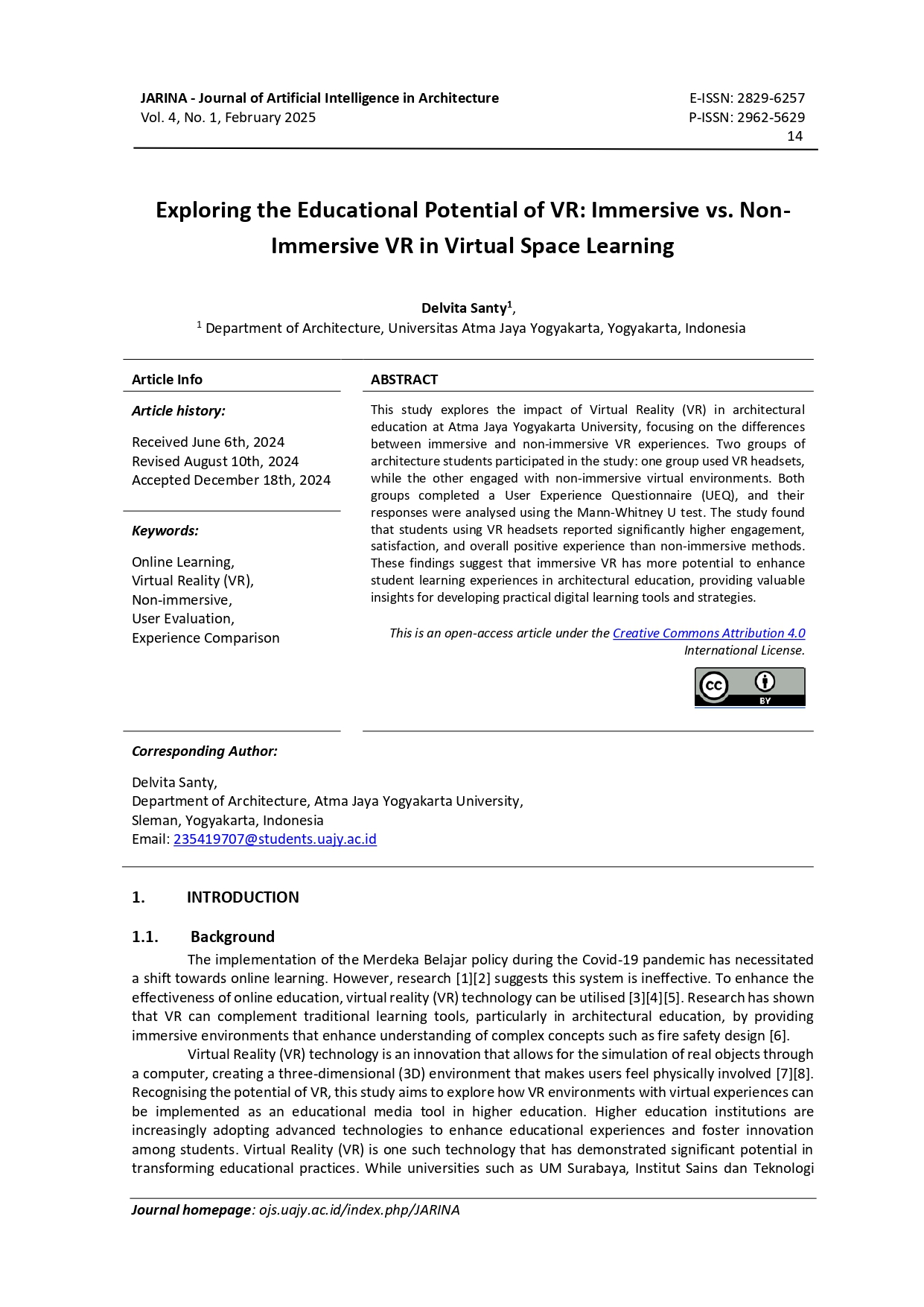Exploring the Educational Potential of VR: Immersive vs. Non-Immersive VR in Virtual Space Learning
DOI:
https://doi.org/10.24002/jarina.v4i1.9333Keywords:
Online Learning, Virtual Reality , Non-immersive VR, User Evaluation, Experience ComparisonAbstract
This study explores the impact of Virtual Reality (VR) in architectural education at Atma Jaya Yogyakarta University, focusing on the differences between immersive and non-immersive VR experiences. Two groups of architecture students participated in the study: one group used VR headsets, while the other engaged with non-immersive virtual environments. Both groups completed a User Experience Questionnaire (UEQ), and their responses were analysed using the Mann-Whitney U test. The study found that students using VR headsets reported significantly higher engagement, satisfaction, and overall positive experience than non-immersive methods. These findings suggest that immersive VR has more potential to enhance student learning experiences in architectural education, providing valuable insights for developing practical digital learning tools and strategies.
References
REFERENCES
[1] Shabir, A. (2022). Ujicoba penggunaan teknologi virtual reality sebagai media pembelajaran. Jurnal Pendidikan Tambusai, 6(1), 696-702.
[2] Sihombing, A. A., Anugrahsari, S., Parlina, N., & Kusumastuti, Y. S. (2021). " Merdeka Belajar" in Online Learning during the COVID-19 Outbreak: Concept and Implementation. Asian Journal of University Education, 17(4), 35-45.
[3] Soumya, D. R., & Madhusudan, J. V. (2022, December). Uses and Impact of Virtual Reality in Open and Distance Higher Education: A Systematic Review. In THE PROCEEDINGS OF THE 4TH INTERNATIONAL CONFERENCE ON VIRTUAL REALITY (Vol. 15, p. 147).
[4] Sarigoz, O. (2019). Augmented reality, virtual reality and digital games: research on teacher candidates. Educational Policy Analysis and Strategic Research, 14(3), 41-63.
[5] Martín-Gutiérrez, J., Mora, C. E., Añorbe-Díaz, B., & González-Marrero, A. (2017). Virtual technologies trends in education. Eurasia journal of mathematics, science and technology education, 13(2), 469-486.
[6] Cininta, M., & Khaerunnisa, K. (2022, November). Utilising Virtual Reality to Support Teaching the Design Principles of the Life-Safety System. In International Conference on Sustainability in Creative Industries (pp. 63-76). Cham: Springer Nature Switzerland.
[7] Lorusso, M., Rossoni, M., & Colombo, G. (2020). Conceptual modelling in product design within virtual reality environments. Computer-Aided Design and Applications, 18(2), 383-398.
[8] Jumani, A. K., Siddique, W. A., Laghari, A. A., Abro, A., & Khan, A. A. (2022). Virtual reality and augmented reality for education. In Multimedia computing systems and virtual reality (pp. 189-210). CRC Press.
[9] Mystakidis, S., Berki, E., & Valtanen, J. P. (2021). Deep and meaningful e-learning with social virtual reality environments in higher education: A systematic literature review. Applied Sciences, 11(5), 2412.
[10] Al Farsi, G., Yusof, A. B. M., Romli, A., Tawafak, R. M., Malik, S. I., Jabbar, J., & Bin Rsuli, M. E. (2021). A Review of Virtual Reality Applications in an Educational Domain. International Journal of Interactive Mobile Technologies, 15(22).
[11] Liu, R., Wang, L., Lei, J., Wang, Q., & Ren, Y. (2020). Effects of an immersive virtual reality‐based classroom on students’ learning performance in science lessons. British Journal of Educational Technology, 51(6), 2034-2049.
[12] Coban, M., Bolat, Y. I., & Goksu, I. (2022). The potential of immersive virtual reality to enhance learning: A meta-analysis. Educational Research Review, 36, 100452.
[13] Childs, E., Mohammad, F., Stevens, L., Burbelo, H., Awoke, A., Rewkowski, N., & Manocha, D. (2023). An overview of enhancing distance learning through emerging augmented and virtual reality technologies. IEEE transactions on visualization and computer graphics.
[14] Panerai, S., Gelardi, D., Catania, V., Rundo, F., Tasca, D., Musso, S., ... & Ferri, R. (2021). Functional living skills: a non-immersive virtual reality training for individuals with major neurocognitive disorders. Sensors, 21(17), 5751.
[15] Wang, M., Yu, H., Bell, Z., & Chu, X. (2022). Constructing an edu-metaverse ecosystem: A new and innovative framework. IEEE Transactions on Learning Technologies, 15(6), 685-696.
[16] Koohang, A., Nord, J. H., Ooi, K. B., Tan, G. W. H., Al-Emran, M., Aw, E. C. X., ... & Wong, L. W. (2023). Shaping the metaverse into reality: a holistic multidisciplinary understanding of opportunities, challenges, and avenues for future investigation. Journal of Computer Information Systems, 63(3), 735-765.
[17] Yoo, K., Welden, R., Hewett, K., & Haenlein, M. (2023). The merchants of meta: A research agenda to understand the future of retailing in the metaverse. Journal of Retailing, 99(2), 173-192.
[18] Caldas, O. I., Sanchez, N., Mauledoux, M., Avilés, O. F., & Rodriguez-Guerrero, C. (2022). Leading presence-based strategies to manipulate user experience in virtual reality environments. Virtual Reality, 26(4), 1507-1518.
[19] Winkler, N., Röthke, K., Siegfried, N., & Benlian, A. (2020). Lose yourself in VR: exploring the effects of virtual reality on individuals’ immersion.
[20] Gerschütz, B., Fechter, M., Schleich, B., & Wartzack, S. (2019, July). A review of requirements and approaches for realistic visual perception in virtual reality. In Proceedings of the Design Society: International Conference on Engineering Design (Vol. 1, No. 1, pp. 1893-1902). Cambridge University Press.
[21] Etemadpour, R., Kozlenko, O., & Dwivedi, P. (2019, July). A visualization tool for analysing an Assembly Training in VR. In 2019 IEEE 19th International Conference on Advanced Learning Technologies (ICALT) (Vol. 2161, pp. 150-152). IEEE.
[22] Tai, K. Y., Dhaliwal, J., & Balasubramaniam, V. (2022). Leveraging Mann–Whitney U test on large-scale genetic variation data for analysing malaria genetic markers. Malaria Journal, 21(1), 79.

Downloads
Published
How to Cite
Issue
Section
License
Copyright (c) 2025 Delvita Santy

This work is licensed under a Creative Commons Attribution 4.0 International License.
Authors who publish with this journal agree to the following terms:
1.Authors retain copyright and grant the journal right of first publication with the work simultaneously licensed under a Creative Commons that allows others to share the work with an acknowledgement of the work's authorship and initial publication in this journal.
2.Authors are able to enter into separate, additional contractual arrangements for the non-exclusive distribution of the journal's published version of the work (e.g., post it to an institutional repository or publish it in a book), with an acknowledgement of its initial publication in this journal.
3.Authors are permitted and encouraged to post their work online (e.g., in institutional repositories or on their website) prior to and during the submission process, as it can lead to productive exchanges, as well as earlier and greater citation of published work (See The Effect of Open Access).
















